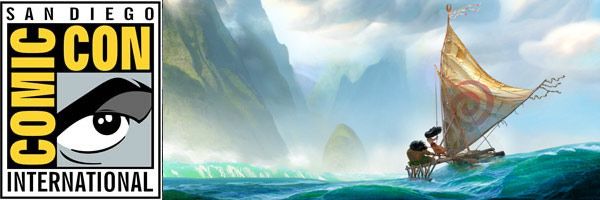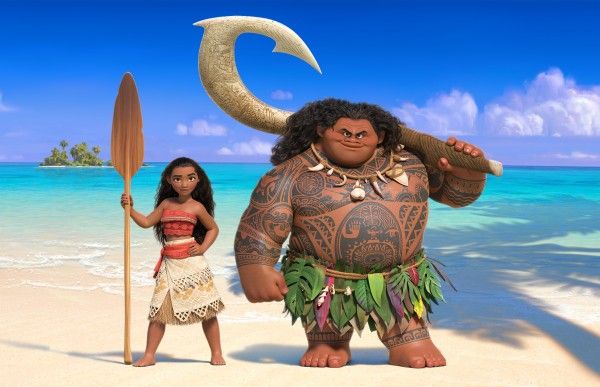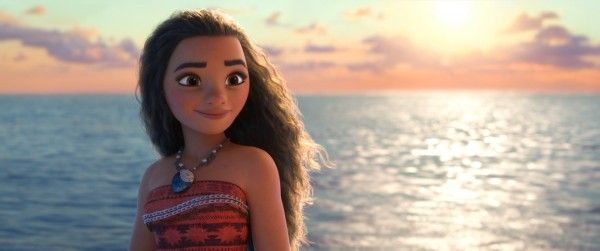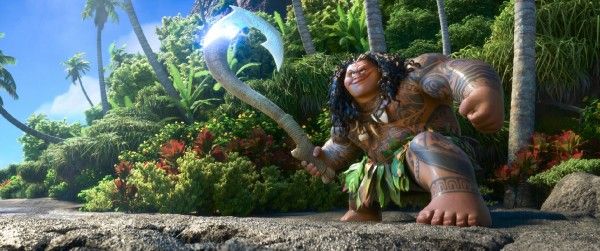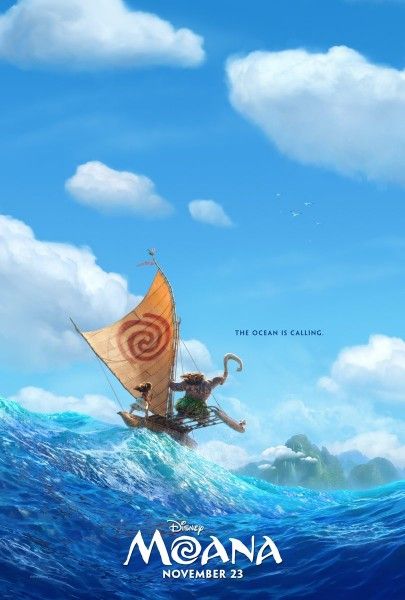Move over, Elsa. Moana is coming. The next Disney princess to grace movie theaters is a fearless Polynesian teenager, setting out on a daring mission to save her people. On her journey, a musical adventure rooted in Polynesian mythology and Pacific Islander culture, she sails across the ocean, befriends a demigod, saves the world -- and most importantly, finds herself.
Ron Clements and John Musker -- storied Disney directors with a legacy of crafting the classics of the Disney Renaissance and beyond, from The Little Mermaid to Princess and the Frog -- came to Comic-Con to share more about Moana. Accompanied by writer Jared Bush (Zootopia), producer Osnat Shurer (Pixar shorts), co-head of animation Amy Lawson Smeed (Frozen), and the voice of Moana herself, Auli'i Cravalho, they presented an exciting introduction to the gorgeous epic years in the making.
-
In a refreshing change from most other Disney princess films, there is no romance in Moana. The focus instead is on Moana's hero's journey, a voyage of empowerment and self-discovery, making her an amazing hero for young girls learning to listen to and value their inner voice. Her voice actor, newcomer Cravalho, describes her as both empowering and empowered, out to try and find herself as any and every teenager out there is looking to do.
- The music of Moana is sure to be astounding, the result of a collaboration between brilliant artists Lin-Manuel Miranda (Hamilton), world music guitarist Opetaia Foa'i, and Mark Mancina (The Lion King). Shurer described the soundtrack as Miranda and Mancina's storytelling-focused contemporary music blended with Opetaia's "heart-stopping roots."
- Musker and Clements started development about five years ago after reading up on Polynesian mythology and becoming intrigued by the ubiquitous trickster god Maui. When they presented their initial ideas to Disney Animation chief creative officer John Lasseter (Toy Story), he told them they could do better, and sent them on a research trip to immerse themselves in the cultures they wanted to write about. They visited Fiji, Samoa, and Tahiti, talking to everyone they could find, from villagers to anthropologists. The experience led them to a deeper understanding of Pacific Islander history and perspectives, meaning they could better incorporate those values into Moana.
- The most valuable thing for Clements was really digging into what it was like to live on an island, and how that affects your point of view of the world. There was a common feeling among those they talked to of having deep relationships with the ocean -- thus the creation of an anthropomorphized ocean as a vital character in the movie.
-
They learned about ancient Polynesian navigation prowess, astounding voyages conducted entirely through dead reckoning -- and that for about a thousand years, there was a "long pause" of Polynesian migration, still not definitively explained by historians. This truly shaped the story they wanted to tell with Moana, crafting their own theory about how those migrations might have started up again. As Clemens put it, "what if there was one particular person who was instrumental in getting things going again?"
- The phrase "know your mountain," a strongly-held principle from people they talked to, also contributed to the essence of Moana's story. It commands that you understand your past and your ancestors in order to understand yourself. If you don't know where and who you came from, then you don't know who you are. That concept forms the emotional base of Moana's journey in the film.
- Maui's intricate tattoos are a central part of his character. One tattoo in particular, a small figure on his chest, has been dubbed Mini Maui, representing his conscience (and as such, often seen annoying Maui and bemoaning his choices). The tattoos required 2D animation on a 3D landscape, a difficult task to pull off well, so Disney brought in the best: the illustrious Eric Goldberg (Aladdin, Hercules, Princess and the Frog). According to Smeed, animators would ask to be assigned to Mini Maui scenes just so they could work with Goldberg.
- Apart from the tattoos, Maui's shirtlessness itself presented a unique challenge, one not often dealt with in Disney movies. Without clothes to hide his anatomy, detailed musculature had to be animated along with all of his movements.
- The variety of elemental characters provided another interesting assortment of animation challenges, leading to constant collaboration with the effects department. The villain is a lava monster rising out of whirls of darkness, while the ocean is itself a central character, requiring the very animation of the water to evoke an array of feelings.
-
Bush was not the first writer throughout the development of Moana. By the time he came on board a year ago, the framework had already been created. Just in the time since he started, though, somewhere in the vicinity of 700 drafts have been written. Bush praised Disney's collaborative and iterative process, which encourages creators to hammer away at their work until the story is what it needs to be.
- Everyone adores Cravalho, who appears to be the true embodiment of her character, vivacious and bold. Her witty, mischievous nature really brought Moana to life. Cravalho herself was clearly thrilled to be in attendance, delighting especially in recounting her first trip to Disneyland was a mere few months ago, where she had a blast meeting all the Disney princesses.
- Tala, Moana's grandmother, introduces the movie in a gorgeous sequence reminiscent of the opening to Hercules. She explains how they used to be a seafaring people, exploring the world, until trickster god Maui stole the jewel-like heart of Tahiti, leading to an all-consuming darkness. She more than anyone else feels the loss of what their people used to have, and looks to Moana to fulfill an ancient prophecy, restoring them to the voyagers they once were.
- Moana's animal friend Pua is a seriously adorable pig. A video of him bouncing and rolling around evoked a passionate chorus of "awww"s from the audience, leading Bush to joke that "the saddest part of the movie is when he gets eaten." Not cool.
- The rooster Hei Hei, another of Moana's companions, was originally conceived as a total jerk, planted as a watchdog by Moana's father. Something about the antagonistic character wasn't resonating, though, so they ended up changing one little thing that made all the difference: they made Hei Hei very, very dumb. The walleyed rooster seems to be pretty useless, but at least "he tries," asserted Bush. "He tries really hard."
- From the day Shurer began work on the movie, she wanted to see Dwayne Johnson play Maui. It's the perfect role for him: he is half-Samoan and deeply connected to the culture, has great comedic timing -- and, Shurer added with a smile, "he's a bit of a demigod himself."
Disney's Moana hits theaters this Thanksgiving.

